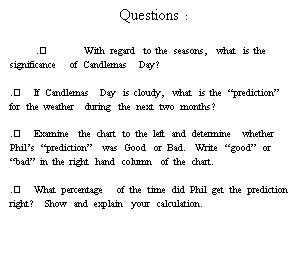 The chart below shows the results of Phil’s appearance over the last few years, along with the average temperature variation from normal in the months following his appearance.
The chart below shows the results of Phil’s appearance over the last few years, along with the average temperature variation from normal in the months following his appearance.

Groundhog Day Background / Folklore
Every February 2nd crowds gather at Gobbler's Knob, in Punxsutawney, Pennsylvania. A groundhog, Punxsutawney Phil, burrowed inside his heated simulated tree trunk, is about to thrust or be pulled into the limelight once again. A pre-dawn fireworks display helps to ignite (hopefully not literally!) the crowd that has gathered in anticipation of Phil's forecast. The awe-inspiring fireworks are set to lively music, which is just what the crowd generally needs at 5:00 am on a cold rural Pennsylvania morn. Phil, and others like him, make the most celebrated weather forecast of the year. Has spring sprung when Phil emerges from his burrow and doesn't see his shadow? Or should he scurry back into his burrow for six more weeks of winter weather if skies are clear and fair?
Groundhog Day has its origins in an ancient celebration of a point mid-way between the Winter Solstice and the Spring Equinox. Superstition has it that fair weather was seen as forbearance of a stormy and cold second half to winter. The early Christians in Europe established the custom of Candlemas Day, when the clergy would bless candles and people would light them in each window of their homes to ward off the darkness of mid-winter.
But the legend of the February 2nd forecast also persisted, as captured in this old English saying:
If Candlemas be fair and bright,
Winter has another flight.
If Candlemas brings clouds and rain,
Winter will not come again.
The trail of groundhog history actually leads back to Clymer H. Freas, city editor of the Punxsutawney Spirit newspaper. In 1887, he was inspired by a group of local hunters and gourmets who held a groundhog hunt followed by a picnic barbecue of, well, you know. Anyway, Freas though it so much fun that he wrote up the group as the Punxsutawney Groundhog Club and went on to promote the Punxsutawney Groundhog as the official weather forecaster. As he embellished the story year after year, other newspapers picked it up and soon everyone looked to Punxsutawney Phil for the critical prediction of when spring would return to the nation.
 The chart below shows the results of Phil’s appearance over the last few years, along with the average temperature variation from normal in the months following his appearance.
The chart below shows the results of Phil’s appearance over the last few years, along with the average temperature variation from normal in the months following his appearance.
Phil see his Average Average Prediction
Year Shadow? Feb. Temps Mar. Temps (Good or Bad)
| 2000 | Yes | Above | Above | |
| 1999 | No | Above | Above | |
| 1998 | Yes | Above | Below | |
| 1997 | No | Above | Above | |
| 1996 | Yes | Above | Below | |
| 1995 | No | Above | Above | |
| 1994 | Yes | Below | Above | |
| 1993 | Yes | Below | Above | |
| 1992 | Yes | Above | Above | |
| 1991 | Yes | Above | Above | |
| 1990 | No | Above | Above | |
| 1989 | Yes | Below | Above | |
| 1988 | No | Below | Above |
5. In 1994, Phil saw his shadow and February was colder than normal. March of 1994 was warmer than normal. Was Phil’s prediction Good or Bad? Explain your answer.
6. Where did the idea that the weather on February 2 could be used to predict future weather originate?
7. Is there any valid reason to believe that the weather on February 2 can be used to predict the weather later in February and March? Explain.